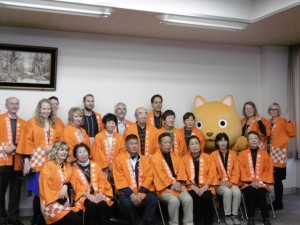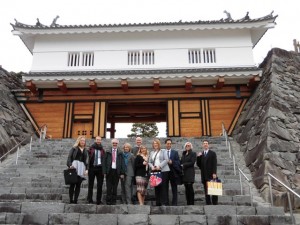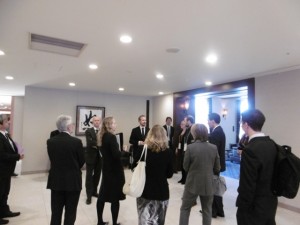I have always wanted to visit Japan and had long had a fascination with the culture and landscape of the place. So getting the opportunity to visit and find out more about how Japanese Local Government organisations are tackling the demographic challenge they face was a fantastic experience and one I will not forget. I think I’d be right in saying that this was how all 10 of us lucky enough to be on the trip felt – a fascination with the place, a significant interest in how they are addressing the challenge of an ageing population – and very fortunate to have been selected to take part in the visit and see an aspect of Japanese life that few tourists ever would.
Japan has a high proportion of its population in the over 65 age group. The birthrate is dropping as fewer people have children and there is virtually no immigration. The dilemma for Japan – and for us in the Western world too increasingly – is how to ensure care and support for the older population with a shrinking workforce and in the current challenged financial climate. With this as the background to the visit we had a fascinating week learning about some of the solutions being sought in Japan and time as a group to reflect on what lessons we might have for our Japanese colleagues, in return.
From the very start our trip was fantastically well organised and we were well supported by Keith Kelly at the London office. This was especially helpful in regard to our grasp of the importance of business etiquette as well as reassurance that we’d be forgiven if we didn’t quite get it right every time. Keith also helped us with some key Japanese phrases and greetings and his enthusiasm for the country and our trip added to the excitement of what was ahead.
Due to a technical fault with my plane from Aberdeen I ended up hours later than planned and in a different airport than planned. Usually this would have been a very stressful start to a trip but thanks to Keith and Katsuko in Tokyo (and Twitter and email!) I had a car waiting to whisk me to the hotel to meet my fellow visitors and the very able, willing and tolerant team from the CLAIR offices in Japan – Katsuko, Arika, Hiroaki and our indefatigable translator Miyaki. They started our visit as professionally as it went on and I had the full induction and run down of our packed itinerary. Everything that was done to support us was very thoughtful and really helped us all get the most from the visit possible.
Day one of the study was spent in Tokyo where we had an extremely interesting lecture on Japanese Government and Local Government and some background into the challenge of elder care in a country with a very ageing population, low birth rate and little immigration. This set the context to our visit very well and Professor Shunsuke Kimura was very generous and good humoured in answering our many questions. We gained a fascinating insight into how Japan is governed and I think we all enjoyed this lecture very much and agreed it provided a valuable background to what was ahead.
The afternoon was spent in the Maihama Club Care Home which has been developed with Swedish Care Home principles in a beautiful building with many traditional Japanese design features. We learnt that a significant number of the residents have a dementia and are frail. We also learnt that the home strives to provide people with person centred care – with an especially focus on making music and in helping residents enjoy delicious traditional food and bathing rituals – very important to Japanese people and their sense of wellbeing. This really was a lovely environment with an impressive philosophy however through the input of Mr Gustav Strandell we learnt that of course not every care home in Japan is as impressive and that there is not a single, unified national or regional grading or review system in place in Japan that helps people know the quality of care homes. This was a significant learning point for us all and one I’ll return to.
That evening we had a formal welcome dinner from our hosts at CLAIR. As with all our other meals we were humbled by the welcome we received and the care with which we were treated. The welcome was warm and the food beautiful to look at and was delicious to eat. This certainly set the bar high for the rest of the week.
The next day saw us heading to Shinjuku station and on the train to Kofu City, Yamanashi – our first real sense of the scale and size of Tokyo through the sheer mass of people thronging the station. But we all managed to stay together thanks to our CLAIR colleagues and enjoyed our bento box lunches on the train.
Yamanashi Prefecture was hosting our visit and our first stop after dropping our bags off at the hotel in Kofu was the prefecture building for a formal greeting from the senior directors of the local government. This was a further test of our formal greeting and gift giving and I think we all acquitted ourselves reasonably well. Once again we were made very welcome and as the trip went on we realised just how much thought and care had gone into organising our visit to make sure we saw as many facilities as possible – as well as the lovely countryside and tourism highlights as it was possible to pack in.
In Kofu local government offices we again started the visit with a series of presentations from senior managers working in elderly care to give us some context of care for older people in the Prefecture. We learnt about the current strategic plan which is seeking to make care seamless for people, deliver local services as near to people as possible and support people to be as healthy as possible for as long as possible. These are all principles that are very familiar to us working in the UK context. Working in Aberdeen where we’ve had high employment for many years, it was fascinating to see the same problems that can arise from the challenges in recruitment and retention in care services – with care homes and other care services having to work very hard to recruit staff to ensure services can be delivered safely. We also heard about the size of the challenge of dementia and the focus being moved into prevention and early identification so that people can be supported at home with their families. I was very interested in hearing about access to health services and while I got a sense that there are ambitions to develop primary care and integrate at the community level, it’s perhaps not as developed in Japan as in the UK. Another interesting contrast was that of the number of people who die in their own homes (or in their care home if that’s their residence). In all 4 of the UK countries we’re working hard to help people have a good death at home as we know that most people choose that as the place they want to die. In contrast in Japan over 80% of older people die in an acute hospital – in some cases just hours after an emergency admission. This comes about because of the law which requires an autopsy in the case of a death not overseen by a medic – something that naturally most families would not want. I think Japan can learn from the work done over decades in the hospice movement in the UK and in more recent campaigns to support palliative care at home as it’s recognised in Japan that the current situation is not person-centred.
Other highlights in and around Yamanashi included:
- Emergency care / telecare services – we got a wonderful welcome here and a live demo of the service. This was clearly a service that cared very much to offer a safety net for people and one that kept people at home as much as possible with the connection to the centre;
- The Minami Alps City Social Welfare Council was a highlight of the trip for all of us – we met the ‘baby-boomer’ older people who volunteer and support their communities and other older people by doing odd jobs, gardening, house clearance and befriending. It was clear that this is a model that would work well in our context and also abundantly clear that the volunteers themselves gained a lot being part of the Council – it seemed a very social and sociable activity and we were particularly impressed by the inter-generational work they had started doing to pass on skills to the younger generation. Again we had a superb welcome and it was a privilege to meet the volunteers and workers of this project; and
- We were able to visit two other care homes in the Prefecture – one in Kofu itself and one in the Five Lakes area – a more rural setting. As with the Minami Club Care home I was impressed by how the owners had tried to create a welcoming and homely place with residents living in smaller group areas with their own familiar Japanese kitchen area and small staff group. We saw how the residents, with support, helped with the laundry – hanging it up, folding it and putting it away. This is to help the focus on normal homely routines and supports people in maintaining what they are able to do for as long as they can. Each of the homes we saw was airy and bright with beautiful natural wooden floors and furnishings and each resident had their own room. One contrast to our context though was that while these were all quite new buildings none had en suite toilets and or showers – as is becoming the norm in Scotland. We were told that this was to encourage the older people to remain mobile and also out of their rooms which were for sleeping in. An interesting perspective on maintaining communal approaches within the homes
From a tourism perspective we were lucky enough as part of our visit to have been shown round:
- The Lumiere Vineyard and Winery – including a delicious tasting. This is the oldest vineyard in Japan and we learnt not normally open to the public to see around. We were lucky to see the workings of the place and taste (and buy!) the product;
- The 5 lakes area and Mount Fuji – it was wonderful to see the iconic Mount Fuji during our visit and as the weather was so kind to us I’m sure we all have many, many pictures of this to remind us of the trip;
- The Maglev visitor and test centre – gave us an insight to the super-fast flying train soon to be speeding through Yamanshi – amazing to see the science behind this and definitely something I’d want to visit when it’s in place!
- Yamanashi Art Gallery – home to the collection of Millet as well as some stunning Japanese traditional art – this was a lovely stop on the trip and gave yet another perspective on the area.
- The Tokiwa Hotel Ryokan and Onsen baths – this was an incredible experience of a real Ryokan – tatami mats and futons and wearing our Yukata and traditional slippers. I think we would have all liked to have stayed on there a few more nights and our traditional multi-course banquet with our hosts was an amazing experience.
I would want to acknowledge the kindness and hospitality we experienced from everyone on the trip. Guiding 10 enthusiastic and independently-minded local government managers (and a Journalist!) is not an easy task but we were guided and supported by Katsuko and her team in such a way as to ensure we were always where we needed to be, on time and with the right information, business cards and gifts. Our translator – Miyaki – was tireless and amazing and as with Arika and Hiroaki – so kind in answering our many questions about Japan and what we were seeing. Mr Hada from the Yamanashi Prefecture accompanied us on that part of the trip and we are grateful to him and his colleagues in making sure that we saw so much of interest in the area – both in relation to elderly care and support, as well as the wonderful countryside and attractions of the area.
On return I have found myself reflecting a lot on what I learnt and the trip has been a wonderful learning experience. I learnt a lot from my fellow Japan Study Tour colleagues who also helped make the experience by being equally enthusiastic and questioning – and I’ll look forward to maintaining those connections through future CLAIR newsletters and alumni events.
I would absolutely encourage people to apply for future Japan Study Tour opportunities – we have a lot to learn from and share with our Japanese colleagues and it is a fabulous opportunity to see how another country and culture is addressing itself to shared issues.
Judith Proctor, Chief Officer, Aberdeen City Health and Social Care Partnership
February 2016
Sign up on our website homepage to receive our eNews updates




